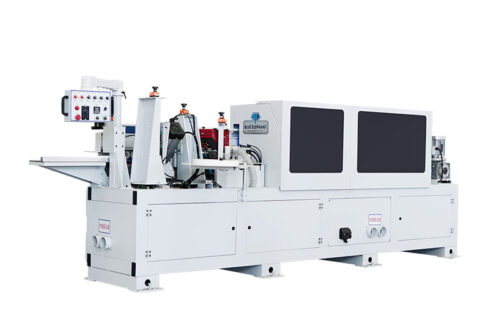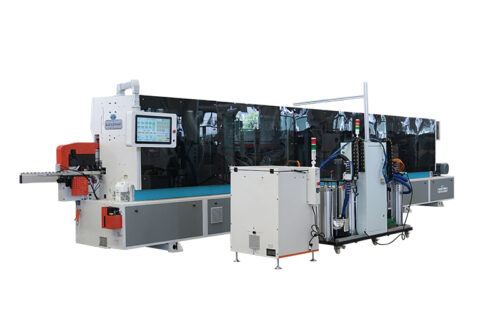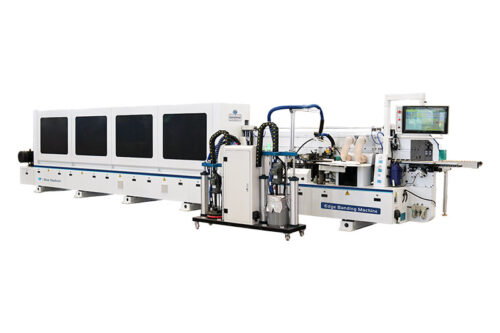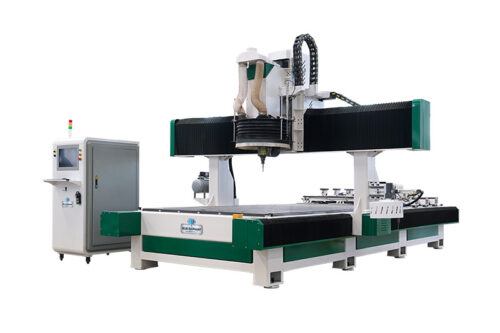I’ll never forget walking into that facility.
It wasn’t a workshop. It wasn’t even a factory floor. It was a warehouse-sized space built around a single CNC machine. The kind that doesn’t sit inside a building but rather, a building is constructed around it.
That’s the level of scale we’re talking about.
If you’re searching for the biggest CNC machines in the world, you’re probably wondering:
- How big are they, really?
- What are they built to do?
- How do they compare to standard machines?
In this article, I’ll take you through 3 of the largest CNC machines ever made, their specs, their capabilities, and their role in modern manufacturing. By the end, you’ll have a clear picture of what extreme-scale CNC machining looks like and why these machines exist in the first place.
Let’s get started!
Quick Comparison
Before we explore each machine in detail, let’s take a quick look at how they compare. These machines are giants in CNC technology, each built for specific tasks, from machining aircraft parts to casting entire car chassis.
Here’s a side-by-side breakdown of their key features:
| Machine | Type | Size & Capacity | Industries Used | Unique Features |
| Schiess VMG6 PS | Vertical Gantry Mill | 236-inch table, 550,000 lbs load capacity | Aerospace, Shipbuilding | Multi-axis control, hydrostatic guides |
| Zimmermann FZ100 | Portal Milling Machine | 40,000 mm X-axis, 22,000 rpm spindle speed | Aerospace, Automotive | Six-axis machining, modular design |
| Bertha | Tunnel Boring Machine | 57.5 ft diameter, 326 ft long, 6,700 tons | Infrastructure, Civil Works | Earth Pressure Balance, automated segment installation |
| Giga Press | High-Pressure Die-Casting | 55,000 kN clamping force, up to 45 castings per hour | Automotive | Integrated melting ovens, vacuum-assisted molding |
| Haas VF-11 | Vertical Machining Center | 120-inch X-axis, 30 hp spindle, 4,000 lbs table load | Aerospace, Manufacturing | Two-speed gearbox, programmable coolant |
Now that you have an overview, let’s take a closer look at each machine’s story, features, and impact.
1. Schiess VMG6 PS
The first time I saw a photo of the Schiess VMG6 PS, I had to do a double take. This machine wasn’t just big, it was on a different level.
It’s one of the largest CNC machines in the world.
Built for extreme precision, it’s used in industries like aerospace, shipbuilding, and energy. These fields need machines that can handle huge, heavy materials without sacrificing accuracy. The Schiess VMG6 PS does exactly that.
Most CNC machines work within limited space. They carve, cut, and drill smaller parts that eventually come together in assembly. This machine? It handles entire sections of airplanes, ships, and massive industrial components, all in one setup.
Specifications
To understand why this machine is so impressive, let’s break down its specs:
| Specification | Details |
| Turning Table Diameter | 236 inches (6,000 mm) |
| Distance Between Columns | 315 inches (8,000 mm) |
| Working Length | 827 inches (21,000 mm) |
| Working Height | 185 inches (4,700 mm) |
| Maximum Load Capacity | 550,000 lbs (250 metric tons) |
| Spindle Power | 256 kW |
| Spindle Speed (Turning) | 0 – 48 rpm |
| Spindle Speed (Milling) | 0 – 7 rpm |
| Maximum Torque | 321 kNm |
| Ram Diameter | 560 mm |
| Ram Stroke | 3,000 mm |
| Axis Configuration | X-Axis: 21,000 mm Y-Axis: 7,000 mm (right), 5,000 mm (left) Z-Axis: 3,000 mm W-Axis (Crossbeam Vertical Adjustment): 4,000 mm |
| Feed Rate | Up to 16,000 mm/min |
| Tool Changer Capacity | 200 slots |
Unique Features & Innovations
The Schiess VMG6 PS isn’t just about size. It has features that make it stand out:
- Advanced CNC Control System: Allows for high-precision milling and turning.
- Hydrostatic Guides: Reduces friction and wear, extending machine life.
- Masterhead System: Adapts different cutting heads for various tasks.
- High Load Capacity: Handles up to 250 metric tons of material.
- Large Tool Changer: Holds 200 tools for continuous machining.
- Customizable Axis Movements: Multiple configurations for different industries.
Challenges and Limitations
No machine is perfect. Even a machine this advanced comes with challenges:
- Cost: Machines of this scale require a massive investment.
- Space Requirements: It needs a huge facility to operate.
- Complex Operation: Skilled operators and regular maintenance are essential.
- Slow Spindle Speeds: Compared to smaller CNCs, spindle speeds are lower to accommodate size.
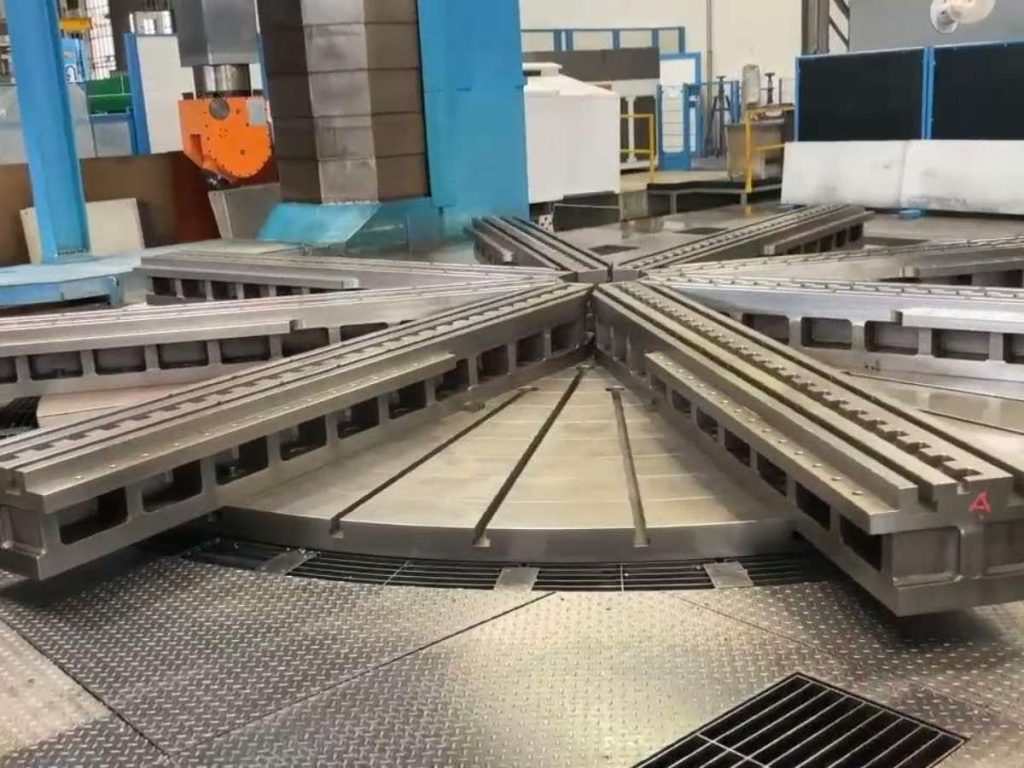
2. Zimmermann FZ100 Portal Milling Machine
Some CNC machines are built for speed. Others are built for power. The Zimmermann FZ100? It’s built for scale and precision.
This machine isn’t just large. It’s one of the biggest portal milling machines in the world.
Designed for industries like aerospace and automotive manufacturing, it can handle massive workpieces while maintaining extreme accuracy.
Imagine machining a full aircraft wing, a car chassis, or a large industrial mold, all in one setup. That’s exactly what the FZ100 is made for. It allows manufacturers to create large, high-precision components without needing multiple machines or setups.
Specifications
To get a sense of its capabilities, let’s look at its technical specifications.
| Specification | Details |
| X-Axis Travel | 3,000 – 40,000 mm |
| Y-Axis Travel | 2,500 – 6,000 mm |
| Z-Axis Travel | 1,000 – 2,500 mm |
| Table Length | 3,000 – 40,000 mm |
| Table Width | 2,500 – 6,000 mm |
| Table Height | 250 mm |
| Maximum Table Load | Up to 5,000 kg/m² |
| Spindle Power | 60 kW |
| Spindle Speed | Up to 22,000 rpm |
| Axis Configuration | 6-axis (X, Y, Z, A, B, C) |
| Machine Weight | Varies based on configuration |
The 6-axis movement allows the machine to reach complex angles and cut with precision from different directions. This level of flexibility is essential for industries where accuracy down to a fraction of a millimeter can make or break a final product.
Unique Features & Innovations
The Zimmermann FZ100 isn’t just big. It’s packed with technology that makes it stand out from other CNC machines.
- M3ABC Milling Head: This advanced milling head allows six-axis machining, making it possible to cut from multiple angles without repositioning the workpiece.
- Modular Design: The machine can be customized to fit different workspace requirements and machining needs.
- Fixed Clamping Table: Holds heavy workpieces securely in place, reducing vibrations and increasing precision.
- Overhead Traveling Portal: Moves smoothly along the X-axis, allowing the machine to work on massive materials without needing repositioning.
- Hydrostatic Guideways: Reduces wear and tear, ensuring smooth, long-term operation.
- High-Speed Spindle: With speeds up to 22,000 rpm, it can cut through tough materials with efficiency.
These features make the FZ100 a powerful, high-precision solution for manufacturing large parts that require both accuracy and efficiency.
Challenges and Limitations
Even with all its strengths, the Zimmermann FZ100 has some limitations.
- Space Requirements: A machine this big needs a large facility. Not every shop can accommodate its size.
- Investment Cost: Advanced technology comes with a high price tag, making it a better fit for large-scale operations rather than small businesses.
- Specialized Training: Operators need extensive training to use all of its features effectively.
- Setup Time: Large workpieces require careful setup and calibration, which can be time-consuming.
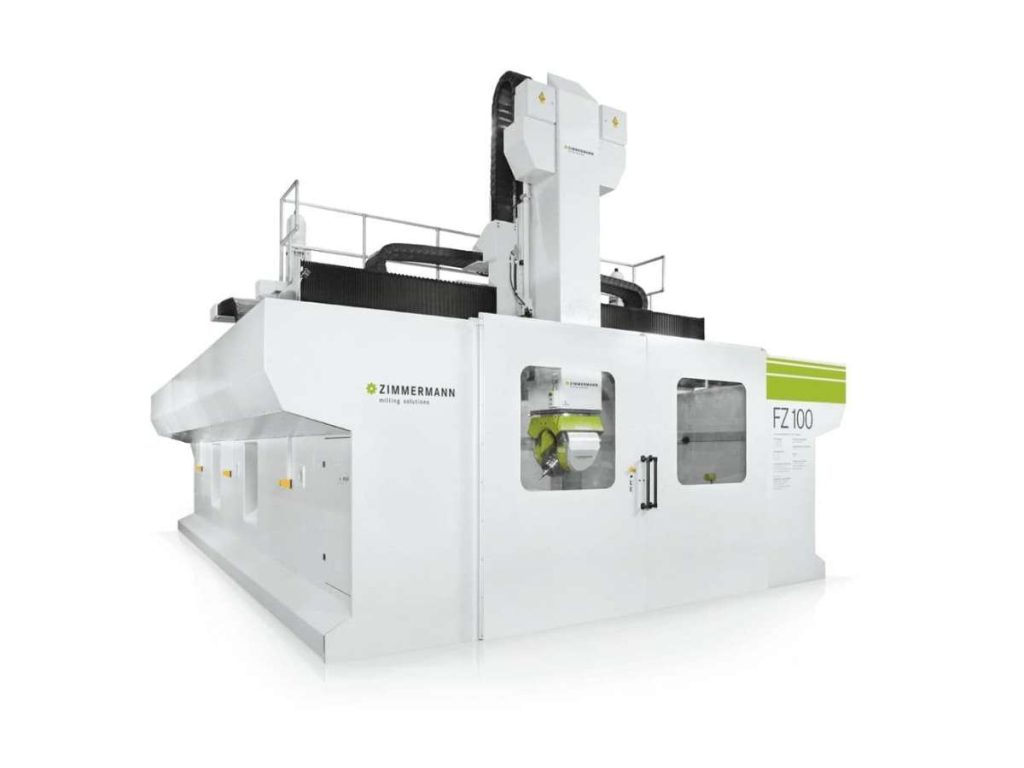
3. Bertha: The World’s Largest Tunnel Boring Machine
But Berth was so large it could dig an entire tunnel beneath a city.
Bertha was built for one purpose: to carve out a tunnel for Seattle’s Alaskan Way Viaduct Replacement Project. The goal was simple but ambitious which is to replace an aging highway with a safer underground route. But digging a 1.7-mile tunnel under a busy city is no small task. It required one of the most powerful and precise CNC-controlled machines ever built.
Bertha’s job was to excavate, remove debris, and reinforce the tunnel walls. This level of automation and precision made it a groundbreaking machine in the world of large-scale infrastructure projects.
Specifications
To understand just how massive Bertha was, take a look at its specs:
| Specification | Details |
| Diameter | 57.5 feet (17.5 meters) |
| Length | 326 feet (99.4 meters) |
| Weight | 6,700 tons (6,070 metric tons) |
| Cutterhead Drive Motors | 24 motors at 505.7 kW (687.5 hp) each |
| Total Power | 12.1 MW (16,500 hp) |
| Maximum Speed | 35 feet per day (10 meters per day) |
| Material Compatibility | Soil, sand, clay, and groundwater |
| Project Cost | $80 million |
Bertha wasn’t designed for speed. Instead, it was built for precision and power.
Tunneling under a city means dealing with unpredictable soil, water pressure, and existing structures. If the machine moved too fast or lost control, it could cause sinkholes or damage nearby buildings.
That’s why every part of Bertha was designed to handle high pressure and extreme conditions. It had to keep working without disturbing the city above it.
Unique Features & Innovations
Bertha wasn’t just big. It had advanced engineering that made it one of the most advanced tunnel boring machines ever built.
- Earth Pressure Balance (EPB) Technology: Allowed Bertha to manage soil pressure, preventing collapses while digging.
- Automated Segment Erector: Installed concrete tunnel walls as it moved forward, reinforcing the tunnel in real time.
- Advanced Navigation System: Used sensors and GPS to keep Bertha on the correct path beneath the city.
- Pressurized Cutterhead Chamber: Handled groundwater and unstable soil while maintaining stability.
Without these features, tunneling in a dense urban environment would be nearly impossible.
Challenges and Limitations
Even a machine this advanced had its share of problems.
- Unexpected Obstructions: In 2013, Bertha hit a hidden steel pipe, damaging its cutting blades. This led to a two-year delay while repairs were made.
- Overheating Issues: Damaged seals caused the main bearing to overheat, forcing engineers to halt operations for repairs.
- Sinkholes and Ground Settlements: The excavation process caused unexpected shifts in the ground, leading to safety concerns and additional delays.
- High Costs and Delays: The project went over budget and took much longer than expected.
These challenges weren’t just technical, they affected an entire city waiting for the project to be completed. But in April 2017, Bertha finally broke through at the tunnel’s end.
For years, Seattle’s drivers faced delays and uncertainty. Bertha was meant to fix that. And despite setbacks, it did. By February 2019, the tunnel was open, creating a safer and more efficient roadway for thousands of commuters.
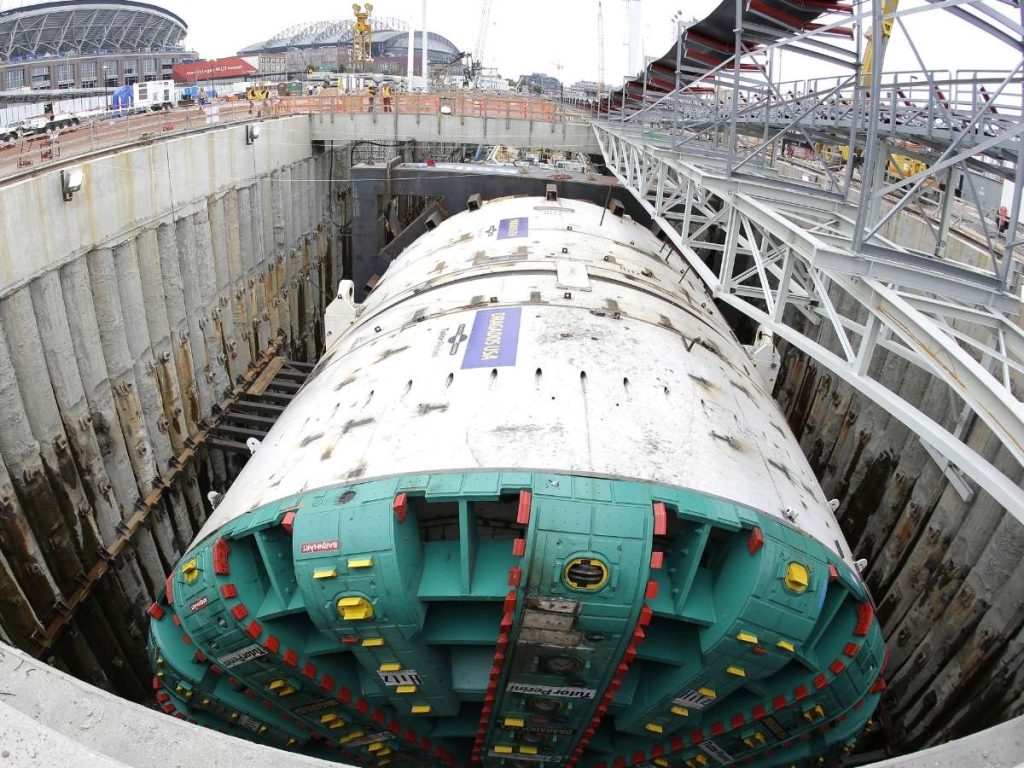
4. Giga Press
When I first heard about the Giga Press, I had to see it to believe it. A machine that can cast an entire car chassis in one piece? It sounded impossible.
But Tesla made it real. Instead of assembling dozens of smaller parts, this high-pressure die-casting machine produces large aluminum sections in a single process. This approach is changing the way cars are built, making production faster, simpler, and more cost-effective.
The idea behind the Giga Press is simple: fewer parts mean fewer welds, less material waste, and a stronger, more durable structure. For manufacturers, this means reduced production time. For consumers, it means safer and more efficient vehicles.
Specifications
The numbers behind the Giga Press show why it is one of the largest and most powerful machines in manufacturing.
| Specification | Details |
| Clamping Force | 55,000 to 61,000 kilonewtons (5,600 to 6,200 tf) |
| Machine Weight | 410 to 430 tonnes (900,000 to 950,000 lbs) |
| Dimensions (L×W×H) | 19.5 m × 5.9 m × 5.3 m (64 ft × 19 ft × 17 ft) |
| Injection System | 5S closed-loop regenerative system |
| Material Compatibility | Aluminum alloys |
| Production Capacity | Up to 45 completed castings per hour |
This level of power and precision allows manufacturers to produce large, complex parts in a way that traditional die-casting machines cannot match.
Unique Features and Innovations
What sets the Giga Press apart is not just its size but the technology behind it.
- 5S Injection System: Regulates pressure and velocity, preventing defects during casting.
- Integrated Melting Ovens: Uses two ovens, one to melt aluminum ingots at 850°C and another to maintain liquid metal at casting temperatures.
- Vacuum-Assisted Molding: A 4,000-liter vacuum tank removes air pockets in the cast, ensuring higher durability.
- Automated Trimming: Mechanical and laser trimming devices remove excess material, reducing the need for manual labor.
These features allow the Giga Press to produce lightweight, high-strength components at a speed and scale that were previously impossible.
Challenges and Limitations
While the Giga Press is a major breakthrough, it does have limitations.
- High Initial Investment: The cost of installing and operating a Giga Press is significant, making it accessible only to large-scale manufacturers.
- Repair Complexity: If a cast part is defective, the entire component must be scrapped, leading to material waste.
- Material Consistency: For uniform strength and solidification in large castings is more challenging than with smaller parts.
- Design Flexibility: The machine is ideal for large, single-piece components but not as effective for smaller, more intricate designs.
Despite these challenges, the Giga Press represents a shift in how manufacturers think about production.
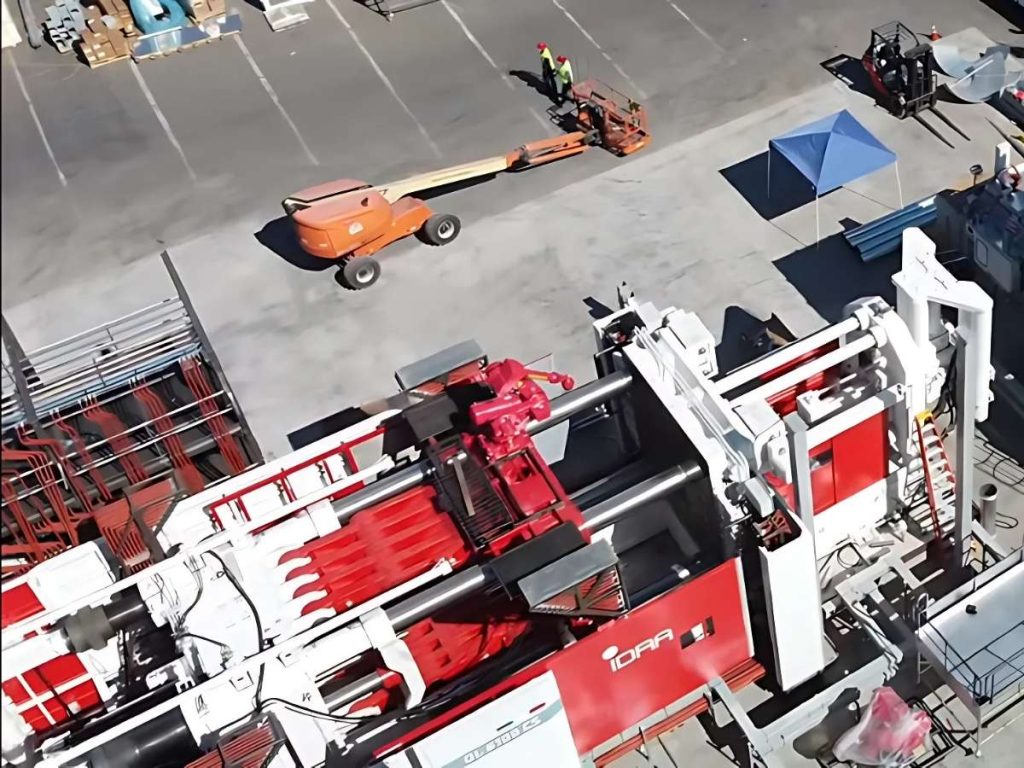
5. Haas VF-11
The first time I saw a Haas VF-11, I underestimated its size.
I had worked with plenty of CNC machines before, big ones, too. But when I walked into the shop and stood next to this 120-inch beast, I realized just how massive it was. It wasn’t just another vertical machining center. It was built for heavy-duty work, the kind of machine that could cut large aerospace parts, industrial molds, and massive steel components with precision that smaller machines just couldn’t match.
If you’ve ever struggled with a machine that couldn’t handle a large workpiece, you know how frustrating it is. Clamping, repositioning, resetting, it eats up time and increases the chance of errors.
The Haas VF-11 eliminates that problem. With its huge work area and high spindle power, you can machine large parts in a single setup, saving hours of work and improving accuracy.
Specifications
When you look at the numbers, it’s easy to see why this machine stands out.
| Specification | Details |
| X-Axis Travel | 120 inches (3048 mm) |
| Y-Axis Travel | 40 inches (1016 mm) |
| Z-Axis Travel | 30 inches (762 mm) |
| Table Dimensions (L×W) | 120 inches × 28 inches (3048 mm × 711 mm) |
| Max Table Load | 4,000 lbs (1814 kg) |
| Spindle Speed | Up to 7,500 RPM |
| Spindle Power | 30 hp (22.4 kW) |
| Spindle Taper | CT or BT 50 |
| Tool Changer Capacity | 30+1 tools |
| Machine Weight | Approximately 35,700 lbs (16,194 kg) |
Unique Features and Innovations
What really makes the VF-11 special is the combination of power and smart features that make machining easier and more efficient.
- 2-Speed Gearbox: Gives high torque for cutting tough metals and high speeds for precision work.
- Programmable Coolant Nozzle: Directs coolant where it’s needed, helping to extend tool life and keep parts from overheating.
- Chip Auger: I used to spend way too much time clearing chips by hand. This system automatically removes chips, keeping the workspace clean.
- Remote Jog Handle: Adjusting a machine this big can be a pain, but the remote control system lets you make fine adjustments without standing right at the control panel.
- Ethernet Connectivity: Makes it easy to transfer programs directly from your network to the machine.
Challenges and Limitations
Like any machine, the VF-11 has some drawbacks.
- Takes Up Space: This is a large machine, so it needs a lot of room in the shop.
- High Initial Cost: The VF-11 is an investment, making it better suited for high-production environments.
- Learning Curve: Advanced features mean operators may need extra training to use the machine efficiently.
If you have the space and the need for large-scale precision machining, the Haas VF-11 is a powerful choice. But for smaller shops, there might be more machines than you need.
Exploring More CNC Options
The world’s largest CNC machines are built for massive projects. They shape ships, airplanes, and tunnels with extreme precision. It’s fascinating to see what they can do.
But for most manufacturers, machines this large aren’t practical. You might need something powerful, but built for your specific work, whether it’s woodworking, metal fabrication, or industrial production.
If you’re exploring CNC machines for business or personal use, there are many options beyond these giants.
Blue Elephant CNC offers a wide range of machines designed for efficiency and precision at different scales. Whether you need a CNC router, fiber laser cutter, or an industrial milling machine, we provide solutions that help manufacturers stay productive and competitive.
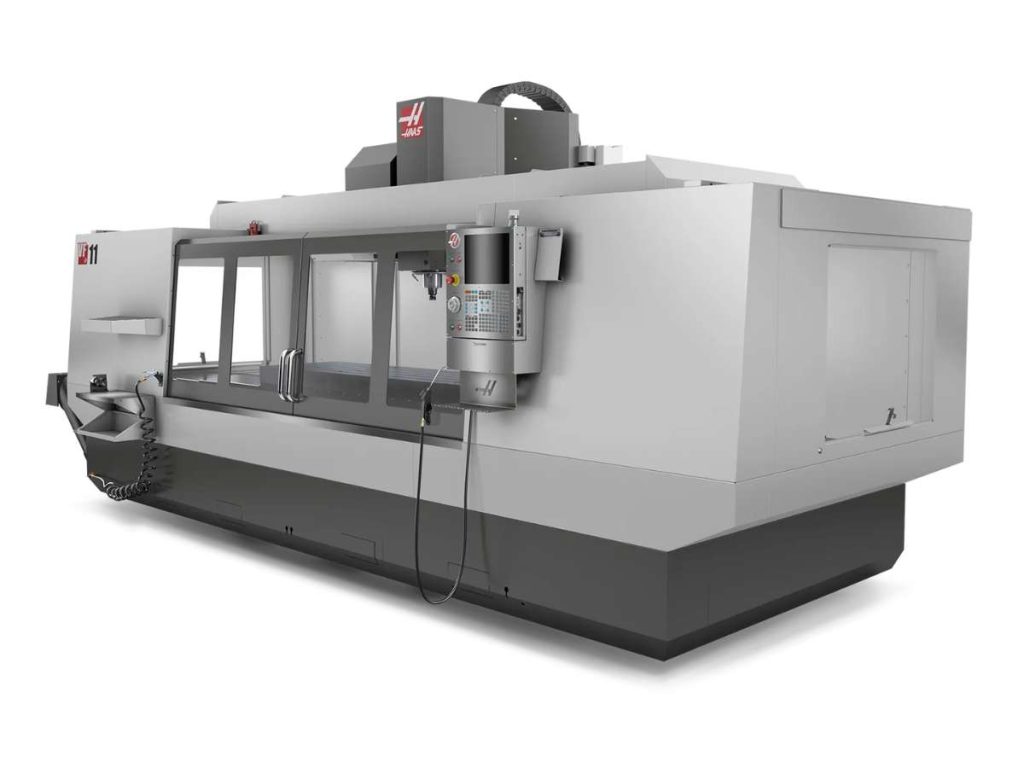
Conclusion
It’s amazing what technology can do. These CNC machines cut, shape, and carve on a scale most of us never imagined. They build our world, literally.
But what about you? What’s your next project? Whether you’re building furniture, machining parts, or creating something unique, you need the right tool for the job.
Blue Elephant CNC provides high-precision, high-efficiency machines for businesses big and small.
So, what are you looking to create? Let’s talk about it.
Contact us today to find the best CNC solution for you.
Recommended Reads for You
If you’re looking for more insights, we’ve put together a list of helpful articles that you might enjoy:
Still haven’t found what you’re looking for? Don’t hesitate to contact us. We’re available around the clock to assist you.


